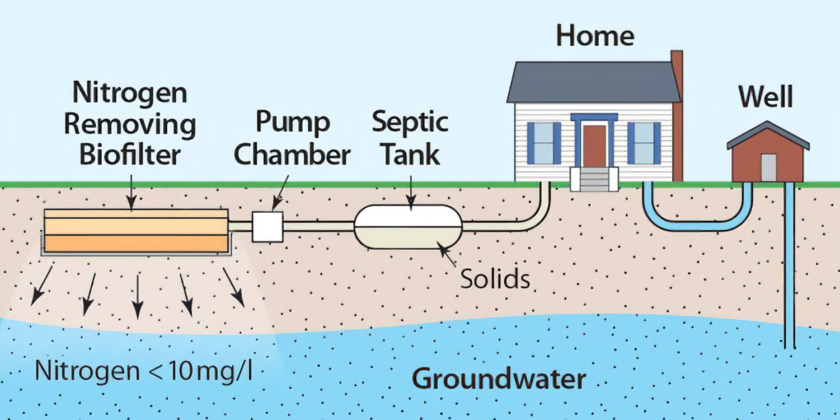Protecting & Restoring Long Island's Peconic Bays

NRBs treat effluent from existing septic tanks with material such as sand, wood chips, and/or biochar that removes nitrogen from septic tank effluent. NRBs passively treat septic tank effluent that is delivered via a low‑energy pump, followed by low-pressure dosing pipes that provide infiltration into a nitrifying sand layer that gravity feeds a woodchip layer, which provides a carbon source for denitrification (SBU CCWT 2016). Biochar is being considered as an amendment to both layers to enhance nitrification and/or denitrification. The pump is controlled to equalize wastewater flow throughout the day, leveling out diurnal peaks to manage to the size of the biofilter. The regularized dosing of the wastewater also provides a pulse of oxygen into the surface of the NRB as wastewater seeps down vertically and is replaced by air / oxygen. The SBU CCWT has developed and is testing three types of NRB (lined, unlined, and wood chip) for approval by Suffolk County (2020a).
Current and future flood risk, sea level rise (SLR), and current and future depth to groundwater should be considered in the evaluation of the appropriate NRB. In areas where the groundwater table is high under current or future SLR scenarios, unlined NRBs would be most appropriate as this system flows directly to groundwater, whereas the lined and woodchip box NRBs require more depth to groundwater as they drain through leaching rings, galleys, or drainfields (Gobler et al. 2021). Recent mapping available through the PEP Climate Ready Assessment will enable evaluation of current and future SLR and depth to groundwater scenarios (Anchor QEA 2019).
The following permits are required for installation of NRBs:
Upon provisional approval, NRB systems will be eligible for the same funding sources (Suffolk County grants and town rebate programs) available installation of Innovative and Alternative On-Site Wastewater Treatment Systems (I/A OWTS) systems. Given the lined and unlined NRBs are within the Pilot Stage of approval of Article 19, its is anticipated they will be provisionally approved in the final quarter of 2022. The woodchip box NRB will enter Pilot Stage in fall 2021 and will be eligible for provisional approval in early 2023.
The extent of nitrogen removal varies among the different systems, but all to be approved, systems need to reduce nitrogen to be below the Suffolk County effluent limit of 19 mg/L and the goal for these NRB systems is reduce nitrogen levels to below 10 mg/L (SBU CCWT 2016). The amount of nitrogen removed is influenced by the in the influent, the amount of nitrogen level of removal in the sand layer, lower temperatures in the winter, and to a lesser extent, residence time in the biofilters (Gobler et al. 2021).
The influent source for the NRB is septic tank effluent, with a concentration of 65 mg/L (CDM Smith 2020). The low and high total nitrogen effluent concentrations, respectively, and are based on the average nitrogen effluent concentrations measured over 16 months from startup for Suffolk County experimental systems by SBU CCWT (Spring 2018 to he influent source for the NRB is septic tank effluent, with an average concentration of 65 mg/L (CDM Smith 2020), although influent entering NRBs installed to date has averaged 80 mg/L and has exceeded 200 mg/L in some cases (CCWT, unpubl) The low and high total nitrogen effluent concentrations, respectively, and are based on the average nitrogen effluent concentrations measured over 16 months from start-up for Suffolk County experimental systems by SBU CCWT (Spring 2018 to Summer 2019; Gobler et al. 2021) and the 2019 average measured by SCDHS (as of December 31, 2019; Suffolk County 2020a).[1]
[1] The SBU CCWT 2021 16 month total nitrogen effluent concentration was higher than the 2019 average measured by SCDHS (2019) for the Woodchip Box System. Therefore, these values were used as the high and low effluent concentrations, respectively.
Individual NRB Nitrogen Effluent Concentrations, Nitrogen Reduction, and Annual Removal Rates
| Technology | Effluent Nitrogen Concentration (mg/L) | Nitrogen Reduction (%) | Annual Nitrogen Removal (lb/yr) |
|---|---|---|---|
| Lined NRB | 8.3–11.4 | 82–87 | 72–76 |
| Unlined NRB | 8.7–10.7 | 84–87 | 73–75 |
| Woodchip Box System | 4–5.3 | 92–94 | 80–82 |
NRB capital and operations and maintenance (O&M) costs are based on Waterloo Biofilter (2001) adjusted to current dollars and scaled to a 4-bedroom (440 gpd) from a 3-bedroom household (330 gallons per day [gpd]). Capital costs assume the same design and engineering cost of $2,500 estimated by Suffolk County for I/A OWTS installation. The lower range capital cost assumes reuse of existing septic system and the higher range assumes replacement. O&M costs include 451-kilowatt-hour (kWh) power, service and maintenance estimated at $250 per year, septic tank pumping at $60 per year, and pump replacement ($300 every 7 years) over 20 years with a 2% inflation rate applied. Electric power cost set at $0.22 per kWh (Suffolk County 2020b). The annualized cost includes capital costs annualized with a 5% discount rate over a 20-year period and the annual average O&M cost. Given these systems are not yet commercially available, cost estimates are the same for the three types of systems.
Individual NRB Capital, O&M, Total Annualized Costs, and Costs per Pound of Nitrogen Removed
| BMP Type | Capital Cost | Average Annual O&M Costs | Annualized Total Cost | Cost per Pound N Removed |
|---|---|---|---|---|
| Lined NRB | $15,924–$19,924 | $527 | $1,805-$2,126 | $24-$30 |
| Unlined NRB | $15,924–$19,924 | $527 | $1,805 | $24-$29 |
| Woodchip Box NRB | $15,924–$19,924 | $527 | $1,805 | $22-$27 |
Sign up for News, Events and Information straight to your inbox.
